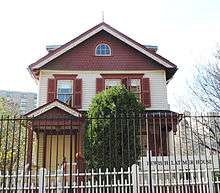Lewis H. Latimer House


The Lewis H. Latimer House, also called the Latimer House or the Lewis Latimer House, was constructed in the Queen Anne style of architecture between 1887 and 1889 by the Sexton family.[1] It served as the home of the African-American inventor Lewis Howard Latimer from 1903 to 1928, and is now operated as a museum dedicated to the inventor's work. In addition, this museum-house also illuminated the life and achievements of other black scientists.[2] The house remained property of the Latimer family until 1963. Currently, the Lewis H. Latimer House is owned by the New York City Department of Parks and Recreation, operated by the Lewis H. Latimer Fund, Inc., and is a member of the Historic House Trust. It is located at 34-41 137th Street in Flushing, Queens.
History
The house, purchased by Latimer in 1903 was in a predominantly white neighborhood in Flushing, Queens.[3] Lewis Latimer sought to work together with members of this community to establish a local chapter of the Unitarian Church as part of his belief in racial integration.[3] There were a number of drawings, dated prior to 1885, on which he claimed his credit as "inventor," found within his Queens home.[3]
This house was a two-and-a-half-story frame house.[2] The house itself, prior to Latimer's purchase of it, was said to be 100 years old.[4]
Latimer, who supervised installation of the first electric lighting system in the city, was honored in his Flushing home by City Councilman Morton Povman (D-Queens).[5] In February, 1986, Povman, to honor the inventor, presented a City Council proclamation to Latimer's granddaughter Winifred Norman, in which he stated: "There aren't many people who have achieved so much in so many fields".[5] Tom Lloyd stated "There are very few houses related to black people designated as landmarks in New York City and State".[2]
Originally located on Holly Avenue, the Latimer House was moved to its current home in Leavitt Field in 1988 when threatened by demolition.[6] A group of citizens who formed the Committee to Save the Latimer House, launched a crusade in order to preserve this historic house.[4] Two such members were Latimer's grandchildren, Gerald Latimer Norman and Winifred Latimer Norman.[4] Tom Lloyd and Rev. Mitchell with assistance from the Queens Historical Society quickly formed The Committee to Save Latimer House, with those two as co-chairmen; this was done in response to the house’s eminent destruction, reported from William Asadorian, librarian from the Long Island Division of the Queens Borough Public Library.[7] According to Mr. Lloyd, the purpose for relocating the house to the city-owned field on Leavitt Street was because the field was across the street from Latimer Gardens, named after Lewis H. Latimer himself.[2]
It was designated as a landmark by the New York City Landmarks Preservation Commission[8] in 1995[9] following a hearing.[10]
References
- ↑ "Lewis H. Latimer House". The Historic House Trust of New York City. Retrieved February 4, 2008.
- 1 2 3 4 Fried, Joseph P. "A Campaign to Remember an Inventor". NEW YORK TIMES. 6 AUG. 1988
- 1 2 3 Schneider, Janet M. "Blueprint for Change: The Life and Times of Lewis H. Latimer. Queens Borough Public Library. c1995. page 44
- 1 2 3 Norman, Winifred Latimer, and Lily Patterson. "Lewis Latimer: Scientist". Chelsea House Publishers, New York. c1994. page 89
- 1 2 Anonymous. "Ceremony Honors an Inventor Who Helped Light Up the City". NEWSDAY. 10 FEB. 1986
- ↑ "Lewis H. Latimer House". The Historic House Trust of New York City. Retrieved 2008-04-05.
- ↑ Queens Library Store Front Museum/Paul Robeson Theatre Records, 1683-1995, (Bulk 1969-1995) Collection
- ↑ "Landmarks Preservation Commission" (PDF). The New York City Landmarks Preservation Commission. Retrieved 2008-04-05.
- ↑ "Lewis H. Latimer House". Neighborhood Preservation Center. Retrieved 2008-04-05.
- ↑ Norimitsu Onishi (1995-02-12). "Neighborhood Report: Queens up Close; Honoring the Past in the Borough of Homes". The New York Times. Retrieved 2008-04-05.
External links
Coordinates: 40°45′58″N 73°49′46″W / 40.766063°N 73.829402°W